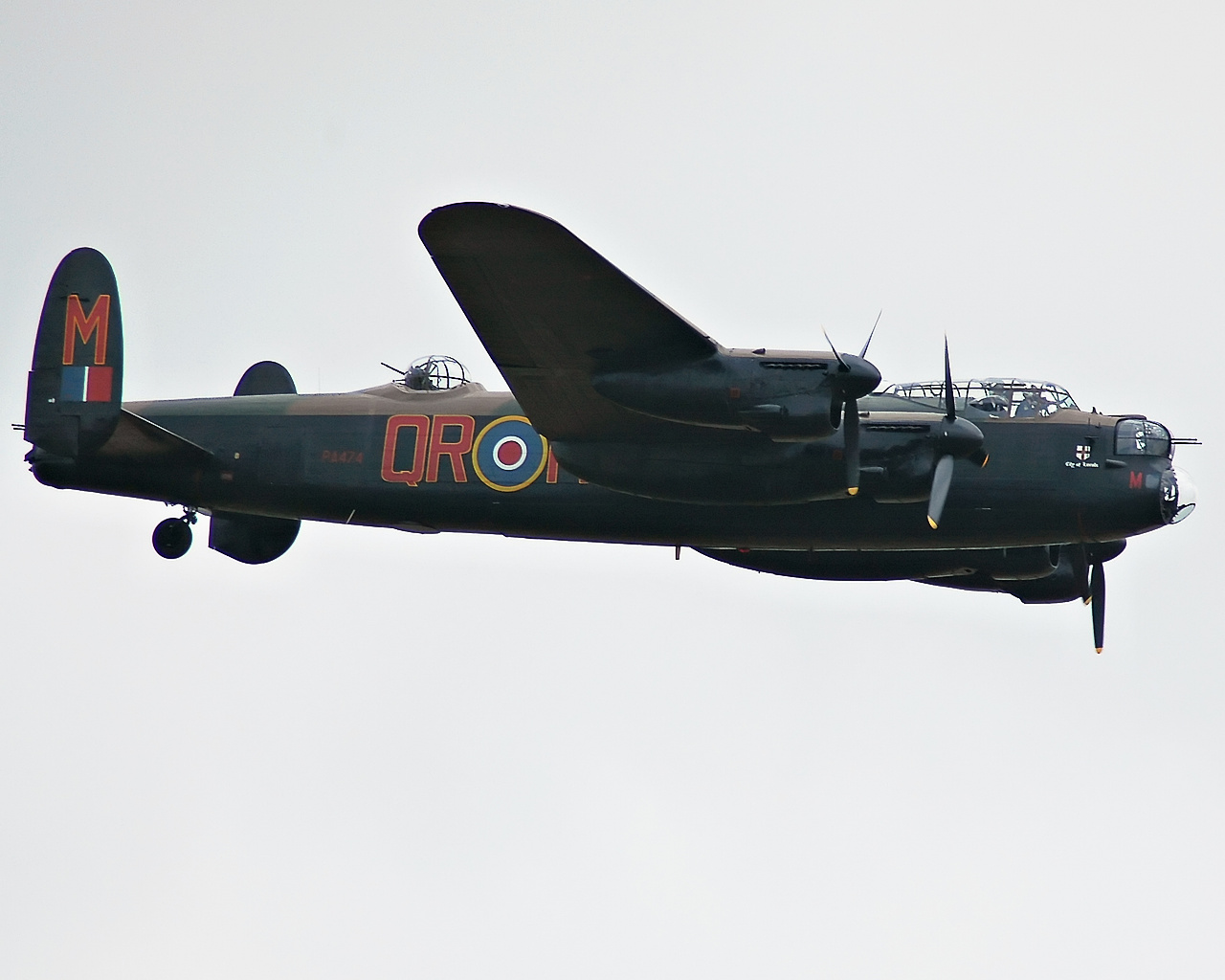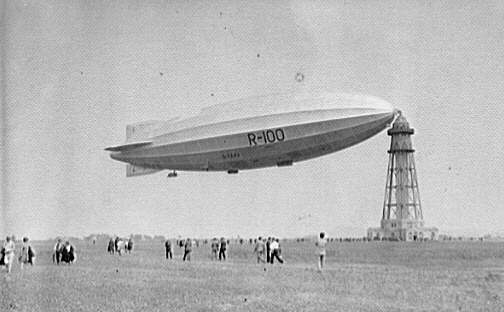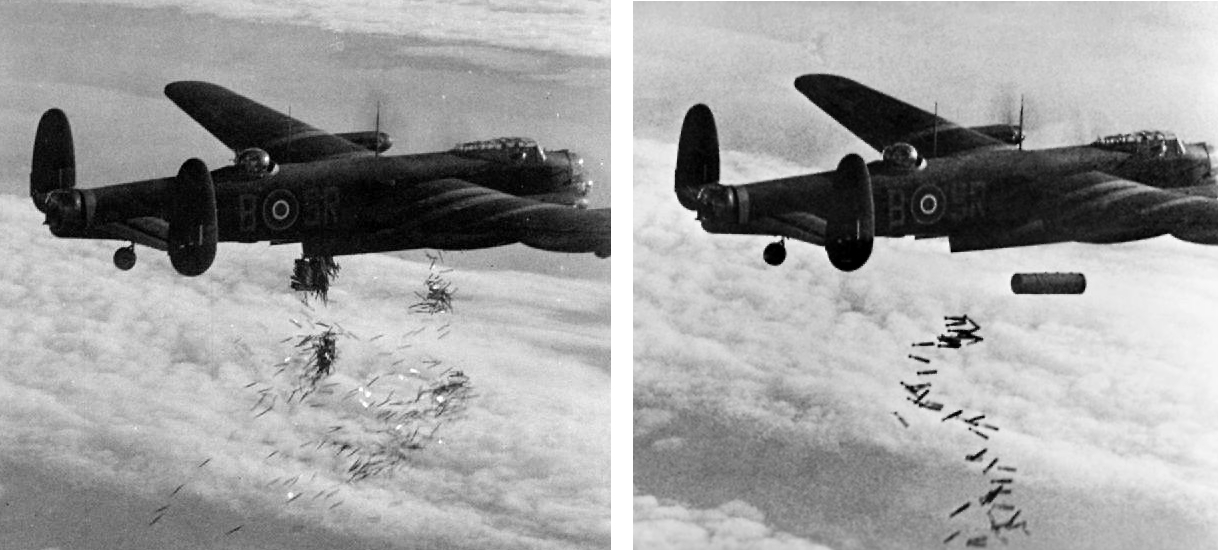|
Avro Lancaster
The Avro Lancaster, commonly known as the Lancaster Bomber, is a British World War II, Second World War heavy bomber. It was designed and manufactured by Avro as a contemporary of the Handley Page Halifax, both bombers having been developed to the same specification, as well as the Short Stirling, all three aircraft being four-engined heavy bombers adopted by the Royal Air Force (RAF) during the same era. The Lancaster has its origins in the twin-engine Avro Manchester which had been developed during the late 1930s in response to the Air Ministry List of Air Ministry specifications, Specification P.13/36 for a medium bomber for "world-wide use" which could carry a torpedo internally, and make shallow dive-bombing attacks. Originally developed as an evolution of the Manchester (which had proved troublesome in service and was retired in 1942), the Lancaster was designed by Roy Chadwick and powered by four Rolls-Royce Merlins and in one of the versions, Bristol Hercules engines. I ... [...More Info...] [...Related Items...] OR: [Wikipedia] [Google] [Baidu] |
WikiProject Aircraft
A WikiProject, or Wikiproject, is an affinity group for contributors with shared goals within the Wikimedia movement. WikiProjects are prevalent within the largest wiki, Wikipedia, and exist to varying degrees within Wikimedia project, sibling projects such as Wiktionary, Wikiquote, Wikidata, and Wikisource. They also exist in different languages, and translation of articles is a form of their collaboration. During the COVID-19 pandemic, CBS News noted the role of Wikipedia's WikiProject Medicine in maintaining the accuracy of articles related to the disease. Another WikiProject that has drawn attention is WikiProject Women Scientists, which was profiled by ''Smithsonian Magazine, Smithsonian'' for its efforts to improve coverage of women scientists which the profile noted had "helped increase the number of female scientists on Wikipedia from around 1,600 to over 5,000". On Wikipedia Some Wikipedia WikiProjects are substantial enough to engage in cooperative activities with outsi ... [...More Info...] [...Related Items...] OR: [Wikipedia] [Google] [Baidu] |
Handley Page Halifax
The Handley Page Halifax is a British Royal Air Force (RAF) four-engined heavy bomber of the Second World War. It was developed by Handley Page to the same specification as the contemporary twin-engine Avro Manchester. The Halifax has its origins in the twin-engine ''H.P.56'' proposal of the late 1930s, produced in response to the British Air Ministry's Specification P.13/36 for a capable medium bomber for "world-wide use." The H.P.56 was ordered as a backup to the Avro 679, both aircraft being designed to use the Rolls-Royce Vulture engine. The Handley Page design was altered to use four Rolls-Royce Merlin engines while the rival Avro 679 was produced as the twin-engine Avro Manchester which, while regarded as unsuccessful mainly due to the Vulture engine, was a direct predecessor of the Avro Lancaster. Both the Lancaster and the Halifax emerged as capable four-engine strategic bombers, thousands of which were used during the War. The Halifax performed its first flight on ... [...More Info...] [...Related Items...] OR: [Wikipedia] [Google] [Baidu] |
Barnes Wallis
Sir Barnes Neville Wallis (26 September 1887 – 30 October 1979) was an English engineer and inventor. He is best known for inventing the bouncing bomb used by the Royal Air Force in Operation Chastise (the "Dambusters" raid) to attack the dams of the Ruhr Valley during World War II. The raid was the subject of the 1955 film '' The Dam Busters'', in which Wallis was played by Michael Redgrave. Among his other inventions were his version of the geodetic airframe and the earthquake bomb, including designs such as the Tallboy and Grand Slam bombs. Early life and education Barnes Wallis was born in Ripley, Derbyshire, to general practitioner Charles George Wallis (1859–1945) and his wife Edith Eyre (1859–1911), daughter of Rev. John Ashby. The Wallis family subsequently moved to New Cross, south London, living in "straitened, genteel circumstances" after Charles Wallis was crippled by polio in 1893. He was educated at Christ's Hospital in Horsham and Haberdas ... [...More Info...] [...Related Items...] OR: [Wikipedia] [Google] [Baidu] |
Bouncing Bomb
A bouncing bomb is a bomb designed to bounce to a target across water in a calculated manner to avoid obstacles such as torpedo nets, and to allow both the bomb's speed on arrival at the target and the timing of its detonation to be predetermined, in a similar fashion to a regular naval depth charge. The inventor of the first such bomb was the British engineer Barnes Wallis, whose "Upkeep" bouncing bomb was used in the Royal Air Force, RAF's Operation Chastise of May 1943 to bounce into German dams and explode underwater, with an effect similar to the underground detonation of the later Grand Slam bomb, Grand Slam and Tallboy bomb, Tallboy earthquake bombs, both of which he also invented. British bouncing bombs After the outbreak of the Second World War in 1939, Wallis saw strategic bombing as the means to destroy the enemy's ability to wage war and he wrote a paper entitled "A Note on a Method of Attacking the Axis powers, Axis Powers". Referring to the enemy's power suppli ... [...More Info...] [...Related Items...] OR: [Wikipedia] [Google] [Baidu] |
Incendiary Device
Incendiary weapons, incendiary devices, incendiary munitions, or incendiary bombs are weapons designed to start fires. They may destroy structures or sensitive equipment using fire, and sometimes operate as anti-personnel weapon, anti-personnel weaponry. Incendiaries utilize materials such as napalm, thermite, magnesium, magnesium powder, chlorine trifluoride, or white phosphorus munitions, white phosphorus. Though colloquially often called "bombs", they are not explosives but in fact operate to slow the process of chemical reactions and use Combustion, ignition rather than detonation to start or maintain the reaction. Napalm, for example, is petroleum especially thickened with certain chemicals into a gel to slow, but not stop, combustion, releasing energy over a longer time than an explosive device. In the case of napalm, the gel adheres to surfaces and resists suppression. Pre-modern history A range of early thermal weapons were utilized by Ancient history, ancient, Middle ... [...More Info...] [...Related Items...] OR: [Wikipedia] [Google] [Baidu] |
Blockbuster Bomb
A blockbuster bomb or cookie was one of several of the largest conventional bombs used in World War II by the Royal Air Force (RAF). The term ''blockbuster'' was originally a name coined by the press and referred to a bomb which had enough explosive power to destroy an entire street or large building through the effects of blast in conjunction with incendiary bombs. Design Blockbuster bombs were the RAF's high capacity (HC) bombs. Their especially thin casings allowed them to contain approximately three-quarters of their weight in explosive, with a 4,000 lb bomb (nominal weight) containing about Amatol, RDX or Torpex. Most general-purpose bombs, termed medium capacity (MC) by the RAF, contained 50% explosive by weight; the remainder consisted primarily of the fragmentation casing. Blockbusters increased in size as the war progressed, rising from the original version to up to . The 4000 lb HC Mark I bomb – actual weight around – was a welded, cylindrical shell of thi ... [...More Info...] [...Related Items...] OR: [Wikipedia] [Google] [Baidu] |
Commonwealth Of Nations
The Commonwealth of Nations, often referred to as the British Commonwealth or simply the Commonwealth, is an International organization, international association of member states of the Commonwealth of Nations, 56 member states, the vast majority of which are former territorial evolution of the British Empire, territories of the British Empire from which it developed. They are connected through their English in the Commonwealth of Nations, use of the English language and cultural and historical ties. The chief institutions of the organisation are the Commonwealth Secretariat, which focuses on intergovernmental relations, and the Commonwealth Foundation, which focuses on non-governmental relations between member nations. Numerous List of Commonwealth organisations, organisations are associated with and operate within the Commonwealth. The Commonwealth dates back to the first half of the 20th century with the decolonisation of the British Empire through increased self-governance ... [...More Info...] [...Related Items...] OR: [Wikipedia] [Google] [Baidu] |
Strategic Bombing During World War II
World War II (1939–1945) involved sustained strategic bombing of railways, harbours, cities, workers' and civilian housing, and industrial districts in enemy territory. Strategic bombing as a military strategy is distinct both from close air support of ground forces and from Air supremacy#World War II, tactical air power. During World War II, many military strategists of air power believed that air forces could win major victories by attacking industrial and political infrastructure, rather than purely military targets. Strategic bombing often involved bombing areas inhabited by Non-combatant, civilians, and some campaigns were deliberately designed to target civilian populations in order to terrorism, terrorize them or to weaken their morale. International law at the outset of World War II did not specifically forbid the aerial bombardment of cities – despite the prior occurrence of such bombing during World War I (1914–1918), the Spanish Civil War (1936–1939), and t ... [...More Info...] [...Related Items...] OR: [Wikipedia] [Google] [Baidu] |
RAF Bomber Command
RAF Bomber Command controlled the Royal Air Force's bomber forces from 1936 to 1968. Along with the United States Army Air Forces, it played the central role in the Strategic bombing during World War II#Europe, strategic bombing of Germany in World War II. From 1942 onward, the British bombing campaign against Germany became Area bombing directive, less restrictive and increasingly targeted industrial sites and the civilian manpower base essential for German war production. In total 501,536 operational sorties were flown, of bombs were dropped and 8,325 aircraft lost in action. Bomber Command crews also suffered a high casualty rate: 55,573 were killed out of a total of 125,000 aircrew, a 44.4% death rate. A further 8,403 men were wounded in action, and 9,838 became prisoners of war. Bomber Command stood at the peak of its post-war Armed forces, military power in the 1960s, the V bombers holding the United Kingdom's nuclear deterrent and a supplemental force of English Electric ... [...More Info...] [...Related Items...] OR: [Wikipedia] [Google] [Baidu] |
Bristol Hercules
The Bristol Hercules is a 14-cylinder two-row radial aircraft engine designed by Sir Roy Fedden and produced by the Bristol Engine Company starting in 1939. It was the most numerous of their single sleeve valve ( Burt-McCollum, or Argyll, type) designs, powering many aircraft in the mid-World War II timeframe. The Hercules powered a number of aircraft types, including Bristol's own Beaufighter heavy fighter design, although it was more commonly used on bombers. The Hercules also saw use in civilian designs, culminating in the 735 and 737 engines for such as the Handley Page Hastings C1 and C3 and Bristol Freighter. The design was also licensed for production in France by SNECMA. Design and development Shortly after the end of World War I, the Shell company, Asiatic Petroleum, commissioned Harry Ricardo to investigate problems of fuel and engines. His book was published in 1923 as “The Internal Combustion Engine”. Ricardo postulated that the days of the poppet valve ... [...More Info...] [...Related Items...] OR: [Wikipedia] [Google] [Baidu] |
Rolls-Royce Merlin
The Rolls-Royce Merlin is a British Coolant#Liquids, liquid-cooled V12 engine, V-12 Reciprocating engine, piston aero engine of 27-litre (1,650 cu in) Engine displacement, capacity. Rolls-Royce Limited, Rolls-Royce designed the engine and first ran it in 1933 as a private venture. Initially known as the PV-12, it was later called ''Merlin (bird), Merlin'' following the company convention of naming its four-stroke piston aero engines after birds of prey. The engine benefitted from the racing experiences of precursor engines in the 1930s. After several modifications, the first production variants of the PV-12 were completed in 1936. The first operational aircraft to enter service using the Merlin were the Fairey Battle, Hawker Hurricane and Supermarine Spitfire. The Merlin remains most closely associated with the Spitfire and Hurricane, although the majority of the production run was for the four-engined Avro Lancaster heavy bomber. The Merlin continued to benefit from a s ... [...More Info...] [...Related Items...] OR: [Wikipedia] [Google] [Baidu] |
Medium Bomber
A medium bomber is a military bomber Fixed-wing aircraft, aircraft designed to operate with medium-sized Aerial bomb, bombloads over medium Range (aeronautics), range distances; the name serves to distinguish this type from larger heavy bombers and smaller light bombers. Mediums generally carried about two tons of bombs, compared to light bombers that carried one ton, and heavies that carried four or more. The term was used prior to and during World War II, based on available parameters of Aircraft engine, engine and Aerospace engineering, aeronautical technology for bomber aircraft designs at that time. After the war, medium bombers were replaced in world air forces by more advanced and capable aircraft. History In the early 1930s many air forces were looking to modernize their existing bomber aircraft fleets, which frequently consisted of older biplanes. The new designs were typically twin-engined monoplanes, often of all-metal construction, and optimized for high enough pe ... [...More Info...] [...Related Items...] OR: [Wikipedia] [Google] [Baidu] |










